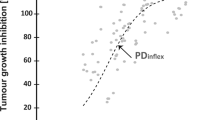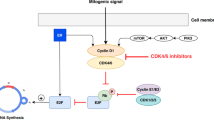Abstract
Purpose
Pharmacokinetic/pharmacodynamic (PK/PD) models have been shown to be useful in predicting tumor growth rates in mouse xenografts. We applied novel PK/PD models to the published anticancer combination therapies of tumor growth inhibition to simulate synergistic changes in tumor growth rates. The parameters from the PK/PD model were further used to estimate clinical doses of the combination.
Methods
A PK/PD model was built that linked the dosing regimen of a compound to the inhibition of tumor growth in mouse xenograft models. Two subsequent PK/PD models were developed to simulate the published tumor growth profiles of combination treatments. Model I predicts the tumor growth curve assuming that the effect of two anticancer drugs, AZD7762 and irinotecan, is synergistic when given in combination. Model II predicts the tumor growth curve assuming that the effect of co-administering flavopiridol and irinotecan is maximally synergistic when dosed at an optimal interval.
Results
Model I was able to account for the synergistic effects of AZD7762 following the administration of irinotecan. When Model II was applied to the antitumor activity of irinotecan and flavopiridol combination therapy, the modeling was able to reproduce the optimal dosing interval between administrations of the compounds. Furthermore, Model II was able to estimate the biologically active dose of flavopiridol recommended for phase II studies.
Conclusions
The timing of clinical combination therapy doses is often selected empirically. PK/PD models provide a theoretical structure useful in the design of the optimal clinical dose, frequency of administration and the optimal timing of administration between anticancer agents to maximize tumor suppression.




Similar content being viewed by others
References
Food and Drug Administration (2004) Innovation: stagnation: challenge and opportunity on the critical path to new medical product 2004
Bergstrom M, Monazzam A, Razifar P, Ide S, Josephsson R, Langstrom B (2008) Modeling spheroid growth, PET tracer uptake, and treatment effects of the Hsp90 inhibitor NVP-AUY922. J Nucl Med 49:1204–1210
Bhattaram VA, Bonapace C, Chilukuri DM, Duan JZ, Garnett C, Gobburu JV, Jang SH, Kenna L, Lesko LJ, Madabushi R, Men Y, Powell JR, Qiu W, Ramchandani RP, Tornoe CW, Wang Y, Zheng JJ (2007) Impact of pharmacometric reviews on new drug approval and labeling decisions—a survey of 31 new drug applications submitted between 2005 and 2006. Clin Pharmacol Ther 81:213–221
Dundr M, Hoffmann-Rohrer U, Hu Q, Grummt I, Rothblum LI, Phair RD, Misteli T (2002) A kinetic framework for a mammalian RNA polymerase in vivo. Science 298:1623–1626
Gobburu JV, Sekar VJ (2002) Application of modeling and simulation to integrate clinical pharmacology knowledge across a new drug application. Int J Clin Pharmacol Ther 40:281–288
Goteti K, Brassil PJ, Good SS, Garner CE (2008) Estimation of human drug clearance using multiexponential techniques. J Clin Pharmacol 48:1226–1236
Guichard S, Chatelut E, Lochon I, Bugat R, Mahjoubi M, Canal P (1998) Comparison of the pharmacokinetics and efficacy of irinotecan after administration by the intravenous versus intraperitoneal route in mice. Cancer Chemother Pharmacol 42:165–170
Janetka JW, Almeida L, Ashwell S, Brassil PJ, Daly K, Deng C, Gero T, Glynn RE, Horn CL, Ioannidis S, Lyne P, Newcombe NJ, Oza VB, Pass M, Springer SK, Su M, Toader D, Vasbinder MM, Yu D, Yu Y, Zabludoff SD (2008) Discovery of a novel class of 2-ureido thiophene carboxamide checkpoint kinase inhibitors. Bioorg Med Chem Lett 18(14):4242–4248
Janetka JW, Ashwell S, Zabludoff S, Lyne P (2007) Inhibitors of checkpoint kinases: from discovery to the clinic. Curr Opin Drug Discov Devel 10:473–486
Magni P, Simeoni M, Poggesi I, Rocchetti M, De Nicolao G (2006) A mathematical model to study the effects of drugs administration on tumor growth dynamics. Math Biosci 200:127–151
Motwani M, Jung C, Sirotnak FM, She Y, Shah MA, Gonen M, Schwartz GK (2001) Augmentation of apoptosis and tumor regression by flavopiridol in the presence of CPT-11 in Hct116 colon cancer monolayers and xenografts. Clin Cancer Res 7:4209–4219
Powell JR, Gobburu JV (2007) Pharmacometrics at FDA: evolution and impact on decisions. Clin Pharmacol Ther 82:97–102
Rocchetti M, Poggesi I, Germani M, Fiorentini F, Pellizzoni C, Zugnoni P, Pesenti E, Simeoni M, De Nicolao G (2005) A pharmacokinetic-pharmacodynamic model for predicting tumour growth inhibition in mice: a useful tool in oncology drug development. Basic Clin Pharmacol Toxicol 96:265–268
Rocchetti M, Simeoni M, Pesenti E, De Nicolao G, Poggesi I (2007) Predicting the active doses in humans from animal studies: a novel approach in oncology. Eur J Cancer 43:1862–1868
Schwartz GK (2005) Development of cell cycle active drugs for the treatment of gastrointestinal cancers: a new approach to cancer therapy. J Clin Oncol 23:4499–4508
Shah MA, Kortmansky J, Motwani M, Drobnjak M, Gonen M, Yi S, Weyerbacher A, Cordon-Cardo C, Lefkowitz R, Brenner B, O’Reilly E, Saltz L, Tong W, Kelsen DP, Schwartz GK (2005) A phase I clinical trial of the sequential combination of irinotecan followed by flavopiridol. Clin Cancer Res 11:3836–3845
Simeoni M, Magni P, Cammia C, De Nicolao G, Croci V, Pesenti E, Germani M, Poggesi I, Rocchetti M (2004) Predictive pharmacokinetic-pharmacodynamic modeling of tumor growth kinetics in xenograft models after administration of anticancer agents. Cancer Res 64:1094–1101
Sung JH, Dhiman A, Shuler ML (2009) A combined pharmacokinetic-pharmacodynamic (PK-PD) model for tumor growth in the rat with UFT administration. J Pharm Sci 98:1885–1904
Wang S, Guo P, Wang X, Zhou Q, Gallo JM (2008) Preclinical pharmacokinetic/pharmacodynamic models of gefitinib and the design of equivalent dosing regimens in EGFR wild-type and mutant tumor models. Mol Cancer Ther 7:407–417
Yamazaki S, Skaptason J, Romero D, Lee JH, Zou HY, Christensen JG, Koup JR, Smith BJ, Koudriakova T (2008) Pharmacokinetic-pharmacodynamic modeling of biomarker response and tumor growth inhibition to an orally available cMet kinase inhibitor in human tumor xenograft mouse models. Drug Metab Dispos 36:1267–1274
Zabludoff SD, Deng C, Grondine MR, Sheehy AM, Ashwell S, Caleb BL, Green S, Haye HR, Horn CL, Janetka JW, Liu D, Mouchet E, Ready S, Rosenthal JL, Queva C, Schwartz GK, Taylor KJ, Tse AN, Walker GE, White AM (2008) AZD7762, a novel checkpoint kinase inhibitor, drives checkpoint abrogation and potentiates DNA-targeted therapies. Mol Cancer Ther 7:2955–2966
Zandvliet AS, Siegel-Lakhai WS, Beijnen JH, Copalu W, Etienne-Grimaldi MC, Milano G, Schellens JH, Huitema AD (2008) PK/PD model of indisulam and capecitabine: interaction causes excessive myelosuppression. Clin Pharmacol Ther 83:829–839
Acknowledgments
The irinotecan and flavopiridol study was supported by a Grant (R01 CA67819) from National Cancer Institute.
Author information
Authors and Affiliations
Corresponding author
Appendix
Appendix
Both Model I and Model II were able to quantitatively describe several experimental data sets. Each parameter in these models was incremently decreased and increased from the optimized fit and the effect on RMSE was evaluated. The sensitivity analysis of each of these parameters for Model I is given in Fig. 5. The sensitivity analysis of each of the parameters for Model II is given in Fig. 6. The sensitivity analysis shows which parameters are more sensitive to the RMSE. Based on this analysis a 5% shift in RMSE was considered to be the cut off to calculate the low and high value of the model parameter (Figs. 5, 6). These values low and high values for each model parameter estimates is given in Table 3. Parameters k1 was least sensitive in model I, whereas parameters k1, k3 and λ1 were less sensitive in model II. Although the low and high values were large for some parameters, the model does captures the tumor growth profiles when the drugs are given in combination. With limited data generated in drug discovery it is hard to get certainity around a parameter estimate, but the message of the utility of the models for such combinations remains.
Rights and permissions
About this article
Cite this article
Goteti, K., Edwin Garner, C., Utley, L. et al. Preclinical pharmacokinetic/pharmacodynamic models to predict synergistic effects of co-administered anti-cancer agents. Cancer Chemother Pharmacol 66, 245–254 (2010). https://doi.org/10.1007/s00280-009-1153-z
Received:
Accepted:
Published:
Issue Date:
DOI: https://doi.org/10.1007/s00280-009-1153-z






